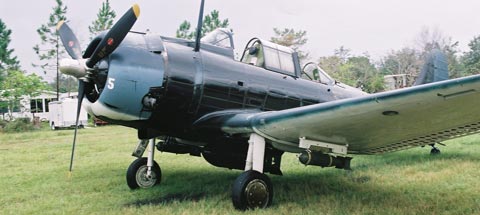Flying historical airplanes like the iconic SBD Dauntless provides a window into aviation’s past—but it’s not always a pretty sight.
Warbird operators like the Commemorative Air Force (CAF) do everything they can to minimize risk. They limit their flying to good weather, install modern avionics, and train regularly.
But there’s no getting around the fact that World War II-era fighters and bombers are complex pieces of machinery with systems that failed regularly when they were new. Seventy years later, those same engines, propellers, and hydraulic and electrical systems can be even more troublesome.
That fact was brought home to me on Nov. 14, 2004, while ferrying the CAF’s irreplaceable SBD Dauntless from Deland, Fla., to its home near Atlanta, Ga. CAF Col. Charles Burcher and I had spent a thoroughly enjoyable weekend at the Deland Naval Aviation Museum’s annual fly-in, and except for patchy clouds in the local area, the weather was forecast to be clear and a million the rest of the way home.
 The Commemorative Air Force's irreplaceable SBD Dauntless was bathed in oil after AOP Pilot Senior Editor Dave Hirschman's emergency landing.
The Commemorative Air Force's irreplaceable SBD Dauntless was bathed in oil after AOP Pilot Senior Editor Dave Hirschman's emergency landing.
After takeoff, ATC cleared us direct to the Craig VOR at Jacksonville, and we were straight and level at 10,000 feet when the usually smooth-running Wright 1820 engine started coming apart. (It had logged about 900 hours since its last overhaul.)
There were a few loud knocks and a noticeable loss of power, but the engine kept running and the gauges were reading normally.
I informed ATC of the “rough-running engine” but inexplicably didn’t declare an emergency. I made a right turn toward Ormond Beach where the weather was VFR and planned a straight-in approach to Runway 9. But there were lots of cumulus clouds in that direction, and the controller said something about thunderstorms. I didn’t hear all of what he said but decided to get below the clouds and find another destination.
I put the airplane in a steep right turn and leveled off below the bases at about 4,000 feet.
I knew the weather also was good at Deland, about 25 miles to the south where we had taken off less than 15 minutes prior. That also seemed like a good place to diagnose and repair our engine problem, and I set it as our new destination.
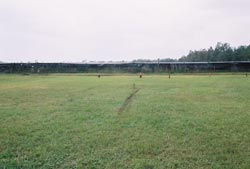 A group of greenhouses at the approach end of the runway made Hirschman unsure if he would make the runway.
A group of greenhouses at the approach end of the runway made Hirschman unsure if he would make the runway.
Ever the optimist, I figured we had blown a cylinder. In fact, a connecting rod had broken and a piston was in the process of disintegrating, spreading metal fragments throughout the 1,200-horsepower engine. It would seize in about five minutes.
The emergency procedures portion of the SBD flight manual calls for touching down gear-up during engine-out landings. But the airplane we were flying had a dummy 1,000-pound bomb strapped to the belly, and there was no way to jettison it. Even so, I resolved to land gear-up if there was no alternative. But the oil pressure needle was still in the green, and I was confident the engine would keep running.
ATC asked about the fuel state and number of souls aboard, and I let them know that there were two of us and that we were carrying nearly 300 gallons of avgas.
They asked whether I wanted emergency equipment standing by at Deland, and I declined.
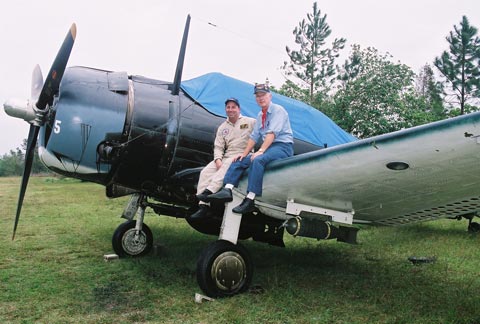 CAF Col. Charles Burcher of Atlanta, a World War II re-enactor, played the role of the back-seat gunner for the flight with Hirschman.
CAF Col. Charles Burcher of Atlanta, a World War II re-enactor, played the role of the back-seat gunner for the flight with Hirschman.
Our situation quickly deteriorated less than six miles away from the airport with the runway in sight at about 3,000 feet agl. Black smoke spilled from the exhaust stacks, and the oil pressure needle was flickering and falling. Engine power was set at 30 inches of manifold pressure, but the engine was clearly in agony and indicated airspeed dropped from about 150 knots to 120 kt.
A straight-in approach would mean flying directly over the town of Deland, and I was trying to decide whether to do it when the engine made the decision for me. It lost power all at once, and we were too far away to glide to the airport.
Fortunately, there was a grass strip, Lee Airport, a sleepy place mostly used by gliders, just off our left wing. The wind was blowing about 20 knots out of the southeast, and I maneuvered sharply to enter a right downwind and base turn.
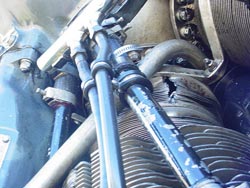 A hole in the base of a cylinder.
A hole in the base of a cylinder.
I lowered the landing gear handle and the two main gear free-fell into position. Even though this was a grass runway, it was a runway, and I saw no reason to make a gear-up landing.
ATC asked if I wanted emergency equipment sent to Lee Airport and I nearly shouted, “Send it!”
During a close-in right base turn, the airplane felt like it was trying to stall and spin to the right. It took nearly full left rudder and left aileron to prevent the airplane from overbanking. (I later learned that the turning moment was caused when the engine seized and the spinning prop abruptly stopped, twisting the crankshaft like a Tootsie Roll.)
Fighting off the turn ate up energy, and on short final, the airplane appeared too low. I was sure the wheels would hit a group of greenhouses at the approach end of the runway, but that was better than making the fatal error of trying to stretch a glide and stalling. To my astonishment and great relief, however, the wheels cleared the obstacles. I hauled the stick full aft over the runway, and the airplane touched down firmly—very firmly—about 100 feet from the threshold, then rolled to a stop in about 1,200 feet. It was my first and only no-flap SBD landing.
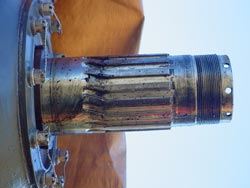 When the engine seized and the spinning prop abruptly stopped, it twisted the crankshaft like a Tootsie Roll.
When the engine seized and the spinning prop abruptly stopped, it twisted the crankshaft like a Tootsie Roll.
Within seconds, Charles was out of airplane with fire extinguisher in hand. The engine was dead, and it had spilled its life blood, 20 gallons of oil, on the sides and belly of the aircraft. It appeared as though the airframe had been dipped in chocolate.
The rustling of the wind through the trees was the only sound.
Before turning off the electricity, I made a last radio call asking the pilot of a nearby King Air to relay a message to ATC: “Let them know that Douglas-Eight-Two-Golf-Alpha is safe on the ground.”
